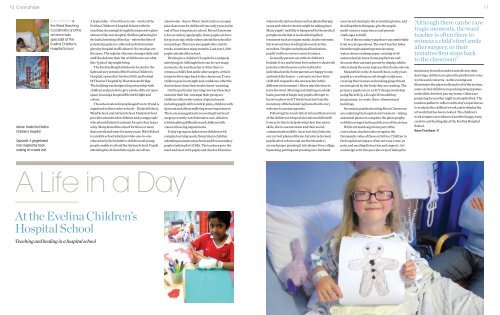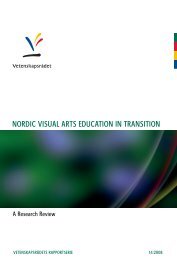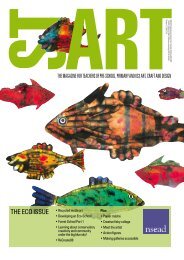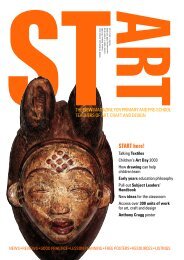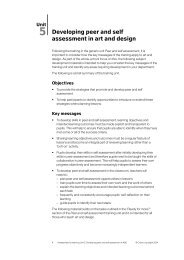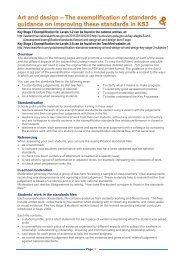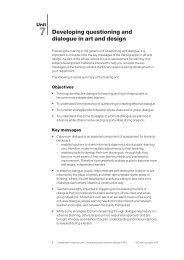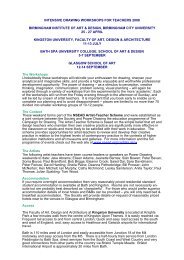08 Secondary: <strong>The</strong> British Museum: inspiring art09British Museum Poster: Inspiring Art112 134 510 112 316 17 18 19<strong>The</strong> British Museum’s potential <strong>for</strong> exploring the human <strong>for</strong>min world art is unsurpassed. Here is just a taste of the diversityof the Museum’s collection: the abstract, the idealised <strong>and</strong> thenaturalistic, 2-D <strong>and</strong> 3-D images, carved, moulded <strong>and</strong> cast, instone, ceramic, metal <strong>and</strong> on paper. Sculptor Marc Quinn’swords are a testament to the Museum’s contemporaryrelevance: “My sculpture of Alison Lapper on TrafalgarSquare’s Fourth Plinth was part of a series inspired by being inthe British Museum <strong>and</strong> seeing how people reacted tofragmented Greek sculptures, with their limbs missing. <strong>The</strong>ysaid how fantastically beautiful they were, the greatest evermade, but if someone the same shape had come into the room,like Alison, they would have been embarrassed.”614 1578 9Key to poster:1. Utagawa Kuniyoshi (1797-1861). <strong>The</strong> Chinese warrior YanQing (detail). Colour woodblock print. Japan, c. 1827-1830.Loaned by Professor Arthur R. Miller (10044)2. Stella Steyn (1907–1987), Schematic figure, lithograph <strong>and</strong>relief print on pink tissue paper, c.1933. © Estate of StellaSteyn, courtesy of the Gorry Gallery, Dublin3. St<strong>and</strong>ing male <strong>and</strong> female pottery figurines. Mexico,200 BC–AD 5004. Ivory statuette of the Virgin <strong>and</strong> Child. Paris, France,c. 1310–13305. Nkisi figure made of wood, iron, nails, string, cloth <strong>and</strong>fibre. Democratic Republic of Congo, Late 19th/early 20thcentury6. Ancestral male figure with tattooed face <strong>and</strong> inlaid haliotisshell eyes. New Zeal<strong>and</strong>, date TBC. Mid 19th century7. Tile depicting a female figure holding a bottle; ceramic,‘Kubachi’ ware; polychrome underglaze painted fritware,Iran, ca. 17008. Brass head of a ruler with a beaded crown. Ife, Nigeria,14th–early 15th century AD9. Silver votive offering in the shape of a h<strong>and</strong>. Syria, 20thcentury10. Painting on paper of a lady st<strong>and</strong>ing by a flowering tree.India, late 18th century11. Porcelain figure of Budai Hesheng. China, Ming Dynasty,148612. Colossal right foot made of marble. Roman, found nearNaples, 1st–2nd century AD13. <strong>The</strong> auspicious marks on the feet of the Buddha. From thestupa at Amaravati, southern India, 2nd century AD14. Painted wooden board of a figure. Papua New Guinea,20th century15. Red-figured amphora with twisted h<strong>and</strong>les. Greece,c. 480 BC.16. Feather god head. Hawaiian Isl<strong>and</strong>s, early 18th century17. St<strong>and</strong>ing figure of the goddess Tara. Sri Lanka, 8th–9thcentury AD18. Marble figure of a woman, Cyclades, Greece, about2800–2300 BC19. Michelangelo (1475–1564), Study <strong>for</strong> Adam in the fresco onthe vault of the Sistine Chapel, red chalk, c. 1511Except where stated, all photographs are © <strong>The</strong> Trustees of theBritish Museum<strong>The</strong> British Museum is launching a range of new taughtprogrammes <strong>and</strong> resources to support art <strong>and</strong> design atsecondary level <strong>and</strong> at AS/A2. Programmes include freegallery-based workshops combining discussion withmaking activities. <strong>The</strong> workshops will explore themes suchas Identity, Environments, Collections <strong>and</strong> Sketchbooks.Students will be encouraged to explore objects contextuallyas well as to make links with contemporary practice <strong>and</strong>society, so developing their ability to think laterally. Onlineresources will provide ideas <strong>for</strong> making the most of a visit tothe Museum <strong>and</strong> include downloadable presentations ondifferent themes <strong>and</strong> topics <strong>for</strong> classroom use. You can alsofind out about study days <strong>for</strong> older students <strong>and</strong> privateviews of new exhibitions. www.britishmuseum.org/schoolsBook reviewAfricanCaribbeanPupils in ArtEducationby Paul DashAfrican Caribbean Pupils in Art EducationPaul Dash, Sense Publishers, Rotterdam, 2010,xvii + 223 pages, ISBN 978-94-6091-048-7This is a pioneering, hard-hitting book whichoffers no easy solutions to some of the mostprotracted issues relating to race <strong>and</strong> education inthe art <strong>and</strong> design classroom, faced by both pupils<strong>and</strong> teachers. This work is clearly focussed on asingle theme, the learning of African Caribbeanpupils in art <strong>and</strong> design classrooms in the UnitedKingdom. <strong>The</strong> author brings to this study a wealthof personal experience <strong>and</strong> reflection about theclassroom. He also offers us the results of a surveyof children’s <strong>and</strong> teachers’ experiences which heundertook to exp<strong>and</strong> his <strong>and</strong> our underst<strong>and</strong>ingof the dynamics involved in multicultural <strong>and</strong>ethnically diverse classrooms, especially oneswhere black pupils <strong>for</strong>m a significant majority.He also offers the reader some valuable resourcematerials <strong>and</strong> references that should enrich thesyllabus <strong>for</strong> all pupils.<strong>The</strong> author’s basic premise is that the slavetrade had a deeply damaging impact on thecultures of those who experiencedtransportation. As Dash writes, ‘the rupture ofthe slave trade has had a lasting often negativeeffect on the way they elaborate a sense of self <strong>and</strong>position themselves in the world’. As a resultAfrican Caribbean cultures, deniedrepresentation, have become invisible. Dashlikens the slave trade to the Big Bang, an eventwhich echoes through the generations <strong>and</strong> stillhas a lasting legacy. Dash employs KamauBraithwaite’s concept of the ‘absence of ruins’ tocharacterise the artistic difficulty that AfricanCaribbeans face in seeking their cultural identity.This is particularly the case <strong>for</strong> the visual arts,where the link with Africa is virtually erased. <strong>The</strong>author cites CLR James’ blunt statement, ‘We areBlack in skin, but the African civilization is notours. <strong>The</strong> basis of our civilization in theCaribbean is an adaptation of Westerncivilization’. But, Dash argues, despite theircontinual contribution to the development ofBritish imperial wealth, African Caribbeansremain, in an important symbolic sense,strangers or outsiders ‘looking into a differentworld of representation to which they are obligedto find an accommodation’. It is a world in whichmany black students feel ambivalent, <strong>and</strong> being‘Black British’ remains <strong>for</strong> them problematic bothat school <strong>and</strong> in the wider world of cultural <strong>and</strong>political identity. Dash warns the teacher thatthese pupils may have scant interest in theCaribbean let alone Africa, <strong>and</strong> ‘Cuba is as alien tothem as Russia or Kurdistan’. What they reallyvalue is the recognition of Black achievement <strong>and</strong>how this contributes to their own self-esteem.<strong>The</strong> author has a high distain <strong>for</strong> some of thenostrums operating today in schools to fostermulticulturalism. He has a particular dislike ofBlack History Month. As one of his intervieweescomments, ‘Black History Month isn’t muchabout black history’. Dash explains, Black HistoryMonth isolates black presence <strong>and</strong> makes itirrelevant, ghettoised. A few iconic figures arecelebrated but the larger hidden history of blackstruggle is neglected.Does this all mean that innovation incurriculum <strong>and</strong> meaningful pupil experience arecondemned to waste? Far from it. Dash makes thecase <strong>for</strong> African Caribbean students as therepresentatives of a new <strong>for</strong>m of hybrid, creolisedculture. ‘<strong>The</strong>y are living exemplars of ourpost-modern state’. As such they may make workin the art classroom which is outside teachers’cultural experiences, but, Dash argues, it is in anissues-based pedagogy that future progress <strong>for</strong>the African Caribbean student lies. <strong>The</strong> authorsuggests that the black body represents <strong>for</strong> suchstudents a unique <strong>and</strong> potent source of expressivepossibilities. Whether it be in <strong>for</strong>ms of walking,clothing or hair styling, new syncretic <strong>for</strong>msenable young people to create new expressivestyles that are decidedly aesthetic, fun <strong>and</strong> seriousmarkers of identity.<strong>The</strong> ‘absence of ruins’ provides cultural space<strong>for</strong> new art <strong>for</strong>ms, whether it be the historicinventions encapsulated in Maroon combsdesigns, the Caribbean Surrealists, Lam <strong>and</strong>Greaves, the Caribbean Artists’ Movement of1966-1972, or the abstraction of Frank Bowling’spaintings celebrated in Rasheed Areen’s splendidexhibition catalogue entitled <strong>The</strong> Other Story.<strong>The</strong>re is now, Dash reminds us, a vibrant recentart history <strong>for</strong> pupils to explore, interrogate <strong>and</strong>even emulate. INIVA <strong>and</strong> Autograph provide avery valuable <strong>and</strong> accessible entry tocontemporary art such as the photography ofIngrid Pollard, the painting of Sonya Boyce <strong>and</strong>Gavin Jantjes <strong>and</strong> the barbershop art of FaisalAbdu’ Allah. Despite the restrictive culture of theexamination syllabuses, there is a world of newartistic practice available <strong>for</strong> pupils to explore inthe classroom. And, Dash reminds us, there areboth MA <strong>and</strong> higher degree programmes now <strong>for</strong>teachers to engage with to help them deliver apedagogy that respects <strong>and</strong> promotes art relevantto the African Caribbean pupil, <strong>and</strong> incidentally,to all of us involved in exploring a postmoderncurriculum.This an excellent <strong>and</strong> challenging account <strong>and</strong>analysis. I hope that, when reprinted, thepublishers will attend to better illustrations <strong>and</strong>an index.Nick Stanley, Research Fellow,Department of Africa, Oceania <strong>and</strong> the Americas,<strong>The</strong> British Museum
10 Cross-phase11Above: Inside the EvelinaChildren’s HospitalOpposite: A gingerbreadman inspired by bookreading on a ward visitRuss Ventham isthe Ward TeachingCoordinator <strong>and</strong> theart <strong>and</strong> musicspecialist at <strong>The</strong>Evelina Children’sHospital SchoolA typical day – if ever there is one – starts at theEvelina Children’s Hospital School with thesunshine streaming through the impressive glassatrium of the new hospital. Staff are gathering <strong>for</strong>the initial meeting of the day – where the lists ofpotential pupils are collected <strong>and</strong> in<strong>for</strong>mationgiven by hospital staff is shared. No two days arethe same. <strong>The</strong> register of names changes daily <strong>and</strong>staff check down their list of children to see whatthis ‘typical’ day might bring.<strong>The</strong> Evelina Hospital School is located in thelight <strong>and</strong> airy atrium of the Evelina Children’sHospital, opened in October 2005, just behindSt Thomas’ Hospital by Westminster Bridge.<strong>The</strong> building was designed in partnership withchildren <strong>and</strong> parents to give a state of the art openspace, housing a hospital filled with light <strong>and</strong>colour.<strong>The</strong> school caters <strong>for</strong> pupils aged two to 19 <strong>and</strong> isorganised in three mini-schools – Dialysis School,Ward School, <strong>and</strong> Atrium School. Dialysis Schoolprovides education <strong>for</strong> children <strong>and</strong> young peoplewho attend dialysis treatment <strong>for</strong> up to four hoursa day. Many attend the school <strong>for</strong> three or moredays a week <strong>and</strong> some <strong>for</strong> many years. Ward Schoolis a mobile school which provides one-to-oneeducation by the bedside to children <strong>and</strong> youngpeople unable to attend the Atrium School. Pupilsattending the Atrium School join one of twoclassrooms – Sun or Moon. Sun Centre is an openplan classroom <strong>for</strong> children from early years to theend of Year 6 in primary school. Moon Classroomis <strong>for</strong> secondary aged pupils. Some pupils are here<strong>for</strong> just one day, while others attend the school <strong>for</strong>several days. <strong>The</strong>re are also pupils who stay <strong>for</strong>weeks, sometimes many months. Last year 1,500pupils attended the school.Working in a children’s’ hospital is a uniquelysatisfying job. Although there can be rare tragicmoments, the ward teacher is often there towitness a child’s first smile after surgery, or theirtentative first steps back to the classroom. To seechildren gain in strength <strong>and</strong> confidence after thedoctors have done their work is heart-warming.On this particular morning two ward teachersexamine their list. Amongst their group arechildren with a wide variety of special needsincluding pupils with cerebral palsy, children withdystonia <strong>and</strong> others suffering recurring seizures.<strong>The</strong>re are young patients recovering from heartsurgery recently out of intensive care, childrenwith breathing difficulties <strong>and</strong> children withvisual or hearing impairments.Today’s group includes seven children withcomplex learning needs, five primary childrenattending mainstream schools <strong>and</strong> five secondarypupils studying <strong>for</strong> GCSEs. <strong>The</strong> teachers go to theward <strong>and</strong> meet with pupils <strong>and</strong> check with nurseswhen medical procedures such as physiotherapy,scans <strong>and</strong> visits to theatre might be taking place.Many pupils’ mobility is hampered by the medicalparaphernalia that is needed during theirtreatment such as oxygen masks, tracheostomies,intravenous lines, feeding tubes <strong>and</strong> cardiacmonitors. Despite such physical limitations,pupils’ resilience never ceases to amaze.Generally parents are at their children’sbedside. It is a useful time <strong>for</strong> teachers to chat withparents so that lessons can be tailored toindividual needs. Some parents are happy to stay<strong>and</strong> watch the lesson – curious to see how theirchild will respond to the new teacher in thisdifferent environment. Others take this time toleave the ward. Meeting <strong>and</strong> chatting on a dailybasis, parents of longer stay pupils often get toknow teachers well. This distraction from themonotony of the bedside vigil can often be verywelcome to anxious parents.Following the ward visits it is found that severalof the children with special needs would benefitfrom activities to help develop their fine motorskills, their concentration <strong>and</strong> their social/communication skills. An art activity linked toour current planned theme Autumn is devised:pupils select colours <strong>and</strong> use their h<strong>and</strong>s toscrunch paper pressing it into shapes <strong>for</strong> a collage.Squeezing, patting <strong>and</strong> pressing are vital h<strong>and</strong>exercises; listening to the scrunching tissue, <strong>and</strong>deciding where things go, give the pupilsmulti-sensory experiences <strong>and</strong> presentchallenges to fulfil.Two of the secondary pupils are uncom<strong>for</strong>tablefrom recent operations. <strong>The</strong> ward teacher takesthem through a painting exercise usingwatercolours on damp paper, creating vividautumn leaf pictures. Some pupils draw <strong>and</strong>decorate their autumn poems <strong>for</strong> display, whilstothers study the same topics as their home schools.Meanwhile in the Atrium School, early yearspupils are working on salt dough sculptures,creating their names <strong>and</strong> making gingerbreadmen inspired by the book they are reading. <strong>The</strong>primary pupils are in an ICT design workshopusing SketchUp, a Google 3D modellingprogramme, to create three-dimensionalbuildings.Secondary pupils attending Moon Classroomare exploring the hospital environment – takingautumnal photos to complete the photographyexhibition staged in the public area of the atrium.While art <strong>and</strong> design <strong>for</strong>m part of thecurriculum, teachers also recognise thetherapeutic value of these activities. Children inthe hospital setting are often nervous, tense, inpain, <strong>and</strong> needing distraction <strong>and</strong> support. Art<strong>and</strong> design activities provide a way of taking the‘Although there can be raretragic moments, the wardteacher is often there towitness a child’s first smileafter surgery, or theirtentative first steps backto the classroom’mind away from discom<strong>for</strong>t <strong>and</strong> often in theirdrawings, children are given the plat<strong>for</strong>m to voiceworries <strong>and</strong> concerns. As the evening sunilluminates the glass walls <strong>and</strong> roof of the atrium,some excited children are packing away pyjamas<strong>and</strong> teddies <strong>for</strong> their journey home. Others arepreparing <strong>for</strong> another night in a hospital bed. <strong>The</strong>teachers gather to reflect on the day’s experiences,to evaluate the children’s work <strong>and</strong> to display theartwork that has been created. <strong>The</strong> children’swork remains as evidence of another happy, busy,creative <strong>and</strong> healing day at the Evelina HospitalSchool.Russ VenthamA Life in a DayAt the Evelina Children’sHospital SchoolTeaching <strong>and</strong> healing in a hospital school


